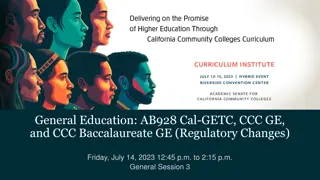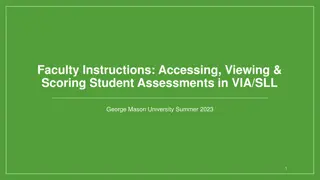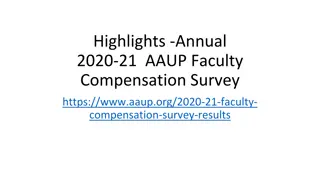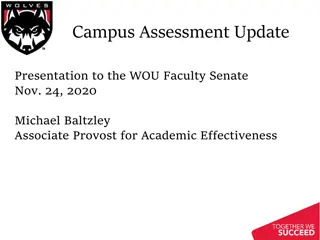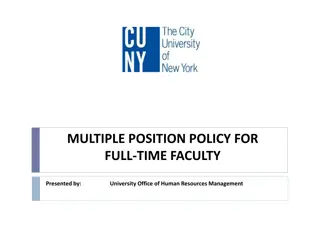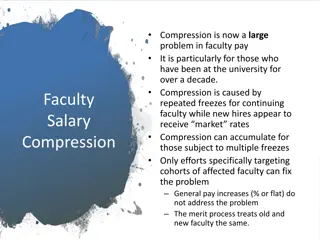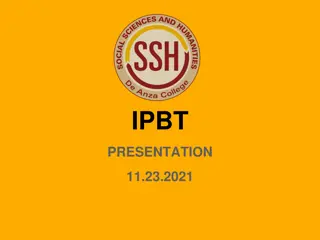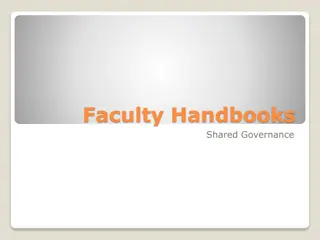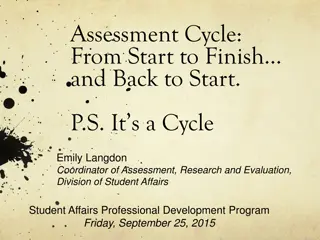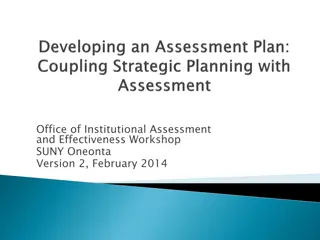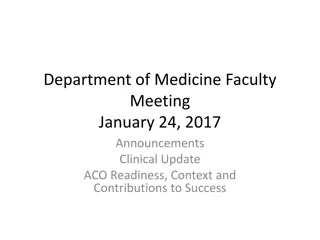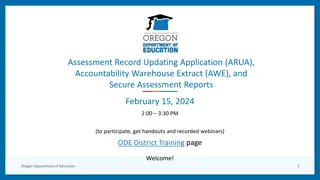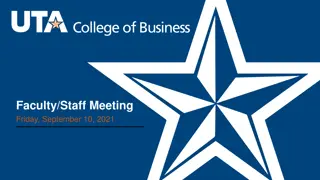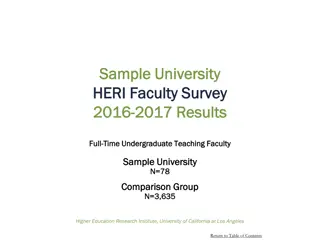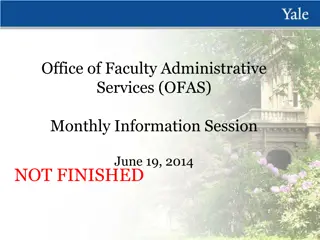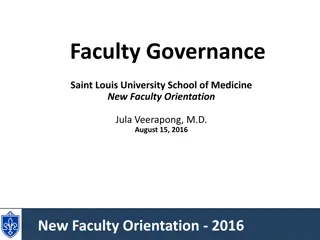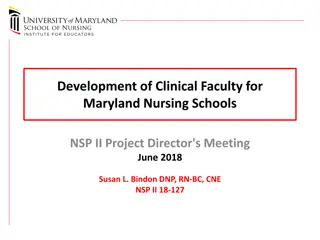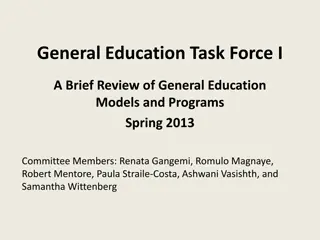FACULTY DEVELOPMENT DAY GENERAL EDUCATION ASSESSMENT
This event aims to discuss assessment misconceptions, best practices, the assessment process, faculty involvement, and feedback collection for General Education outcomes. Topics include crimes preventing a culture of assessment and strategies for rehabilitation.
Download Presentation

Please find below an Image/Link to download the presentation.
The content on the website is provided AS IS for your information and personal use only. It may not be sold, licensed, or shared on other websites without obtaining consent from the author. Download presentation by click this link. If you encounter any issues during the download, it is possible that the publisher has removed the file from their server.
E N D
Presentation Transcript
FACULTY DEVELOPMENT DAY GENERAL EDUCATION ASSESSMENT Donna Sundre, EdD Executive Director, Center for Assessment and Research Studies (CARS) Professor of Graduate Psychology James Madison University Kara Siegert, PhD Director University Analysis, Reporting, & Assessment Salisbury University January 21, 2010
Purpose To encourage a discussion of common assessment misconceptions and description of the assessment process. The ultimate goals for the day are to: provide assessment resources and best practices, describe the assessment process, discuss the role SU faculty will play in developing the assessment process at the institution, and collect feedback from faculty on assessment strategies that they recommend for collecting data on student achievement of General Education outcomes
ITINERARY 9:00-9:15- Introductions & Itinerary 9:15-10:00- Assessment Misconceptions 10:00-10:45-Assessment Process & Assessment at SU 10:45-11:30-Data Collection Methods 11:30-12:00-Developing a Culture of Assessment 12:00-12:30-Working Lunch-Wicomico Room 12:30-1:00- Provost Allen 1:00-1:30- Questions & Introduction to Afternoon Activity 1:30-3:00- Roundtables 3:00-4:00- Faculty Feedback
CRIMES, MISDEMEANORS, AND FELONIES THAT PREVENT A CULTURE OF ASSESSMENT
Crime, Consequence, and Rehabilitation Crime: Practice (or non-practice) that results in the breakdown of the assessment process Consequence: How the crime affects your assessment program Rehabilitation: How to fix the offending behavior Of course there are different levels of offenses; we ve divided our examples into misdemeanors and felonies
Crime: Focus only on Weaknesses Level: Misdemeanor I Consequence: Faculty and administrators complain that assessment focuses on faults Rehabilitation: Look specifically for strengths, report and publicize them; provide balanced feedback
Crime: Use of Unnecessary Jargon Level: Misdemeanor I Consequence: Rolling Eyes (i.e., a lack of interest and, worse, a lack of understanding of results) Rehabilitation: Know your audience. Present at their level. Complex analyses are often useful and appropriate, but offer these in an appendix, technical report, or talk to someone after the meeting.
Crime: GE and the assessment of GE goals and outcomes are the responsibility of the faculty that teach GE only Level: Misdemeanor I Consequence: Faculty teaching in non-General Education courses will disengage with General Education conversations Rehabilitation: GE includes the most fundamental skills and is therefore taught across all courses, majors, and faculty. Faculty from all disciplines should play a role in developing GE assessments.
Crime: Using Course Grades as Evidence of Student Learning Level: Misdemeanor II Consequence: Specific conclusions about student learning and achievement of student learning outcomes cannot be determined making it difficult to close the loop Rehabilitation: Develop assessment methods and evaluation strategies that are directly aligned with learning outcomes
Crime : Forgetting that All Research has Limitations Level: Misdemeanor II Consequence: Faculty will question whether results are indicative of students true ability because Student aren t motivated Sample was too small Test/Instrument isn t perfect We need more analyses, data, etc Rehabilitation: Use the assessment process and results to improve and inform the process. There will always be factors outside of our control. The key is appropriate interpretation of results; faculty should guide this.
Crime: Only Recommending Multiple-Choice Tests for Assessment Level: Misdemeanor III Consequence: Skeptical faculty and administrators. They are more likely to question the validity of the data. Rehabilitation: Use the Student Learning Goals and outcomes to determine the most appropriate method of data collection.
Crime: Surprise Stakeholders with Poor Results Level: Misdemeanor III Consequence: Defensive faculty and administrators. They are more likely to try to undermine assessment efforts. Rehabilitation: Share poor results informally with stakeholders first. Have them brainstorm why results turned out so. Include them in presentations.
Crime: Assessment Reports Collect Dust Level: Felony Consequence: Faculty will consider assessment a bureaucratic exercise invented by administrators and government for the sole purpose of torturing them. Rehabilitation: Make sure time and resources are allotted for faculty to consider and use assessment results.
Crime: Assessment Data Reported at the Individual Faculty Level Level: Felony (Capital Offense) Consequence: Audit mode confirmed; faculty assume results are being use to assess them, not programs. Expect mass hysteria and mutiny. Rehabilitation: There may be none. Administration will need to earn respect. Allow faculty to interpret findings and suggest improvements.
Things to Consider You already do assessment! Systematic basis for making inferences about student development and growth Think about why you go to work everyday your purpose Do you see your students as your partners in learning? What feedback from your partners would be most beneficial for program improvement?
Final Questions What assessment crimes have you seen committed here or at other institutions? What assessment crimes are you most concerned might take place at SU? How can we best assure that these misdemeanors and felonies are not committed at SU? Other Questions, Comments, or Concerns?
Assoc. of American Colleges & Universities Almost all of the institutions surveyed (89 percent) are in some stage of either assessing or modifying their general education program. Assessment of cumulative learning outcomes in general education is, in fact, now becoming the norm. Fifty-two percent of institutions are currently assessing cumulative learning outcomes in general education beyond the level of individual course grades, with another 42 percent reporting that they are planning for assessment of cumulative general education learning outcomes. AAC&U, 2009, Survey of 433 colleges and universities
Stages of the Assessment Process 1. Establishing Goals, Objectives, and/or Outcomes 2. Selecting or Designing Methods 3. Collecting Credible Information 4. Analyzing and Maintaining Information 5. Using Information for Teaching and Learning Improvement *Regardless of the level of assessment required, whether it be a single learning objective, a course, a curriculum, or an entire program, the process is the same.
Stages of the Assessment Process Establishing Objectives/ Outcomes Using Information Selecting/ Designing Instruments Continuous Cycle Analyzing/ Maintaining Information Collecting Information
Student Learning Goals SKILLS 1. Critical Thinking 2.Command of Language 2a. Reading 2b. Writing 2c. Speaking 2d. Listening 3. Quantitative Literacy 4. Information Literacy 4a. Library Use 4b. Computer Technology Use 5. Interpersonal Communication KNOWLEDGE 1. Breadth of Knowledge 1a. Arts 1b. Literature 1c. Civilization 1d. Global Issues 1e. 2nd Culture or Language 1f. Mathematics 1g. Social and Behavioral Sciences 1h. Biological and Physical Sciences 2. Interdependence among Disciplines DISPOSITIONS 1. Social Responsibility 2. Humane Values 3. Intellectual Curiosity 4. Aesthetic Values 5. Wellness
What are Student Learning Outcomes? OUTCOMES Specific knowledge, skills, or attitudes that students are expected to achieve through their college experience Describe observable behavior indicative of learning or development Student-centered! Aligned with the GE goals and the program s mission SpecificMeasurableAttainableReasonable Timely
Curriculum Mapping Example GENERAL EDUCATION STUDENT LEARNING GOALS General Education Student Learning Goals RATING- Rate the level of importance of each outcome OUTCOMES- Specific knowledge or skills students develop through their college experience GEN ED AREA(S)- General Education Sub-group areas that provide courses for students to attain the identified outcome SKILLS- 1. Critical Thinking 3 Assess strengths and weaknesses of arguments in essays written for general audiences. Compose well-reasoned and argued responses to arguments. Sythesize and apply informaton and ideas from readings across disciplines IIA, IIB, IVB, IVC 1 IIA, IIB, IIIA, IIIB, IVC, V 4 IA, IB
Selecting/Designing Instruments Direct measures are best Assess the extent to which students have mastered outcomes via: Multiple-Choice Tests Oral Presentations On-Demand Essays Typically use some combination Course Embedded Essays Portfolios
Locating Instruments Student Learning Goals and Outcomes/Objectives create the engine that drives assessment Search for commercial instruments ($$) ETS, Pearson, ACT, College Base, CLA Search for non-commercial instruments Check alignment with learning outcomes Check measurement properties-reliability and validity
Selecting or Designing Instruments Items and asks Must Match Objectives Create your own blueprint What is the Purpose of Assessment? JMU Example of QR and SR Start off trying to describe level of student learning Move toward describing growth Later establish faculty expectations for GE completers What Type of Instruments? Validating Inferences
Item(s) Assessing Objective 2, 5, 9, 14, 18, 28, 38-41, 55-57 (13 items; 19.7% of test) Cluster 3 - Learning Objectives Scores 1. Describe the methods of inquiry that lead to mathematical truth and scientific knowledge and be able to distinguish science from pseudo- science. M = 9.25 (71% correct) SD = 1.77 = .35 17, 20, 22, 27, 64-66 (7 items; 10.6% of test) M = 4.61 (66% correct) SD = 1.46 = .32 2. Use theories and models as unifying principles that help us understand natural phenomena and make predictions. 1, 15, 16, 43-46 (7 items; 10.6% of test) M = 4.51 (64% correct) SD = 1.61 = .49 3. Recognize the interdependence of applied research, basic research, and technology, and how they affect society. 2, 19, 24-26, 29, 55-57 (9 items; 13.6% of test) M = 6.47 (72% correct) SD = 1.29 = .23 4. Illustrate the interdependence between developments in science and social and ethical issues. 4, 7, 8, 10-13, 21, 30-33, 51-53, 58- 63 (21 items; 31.8% of test) M = 13.74 (65% correct) SD = 3.06 = .59 5. Use graphical, symbolic, and numerical methods to analyze, organize, and interpret natural phenomenon. 3, 34-37, 53, 60-63 (10 items; 15.2% of test) M = 5.93 (59% correct) SD = 1.77 = .44 6. Discriminate between association and causation, and identify the types of evidence used to establish causation 5, 6, 9-13, 18, 23, 28, 41, 42, 47-50, 54, 59, 60, 62, 63 (21 items; 31.8% of test) M = 15.10 (72% correct) SD = 2.74 = .55 7. Formulate hypotheses, identify relevant variables, and design experiments to test hypotheses. 2, 14, 24-26, 29, 38-40, 60-63 (13 items; 19.7% of test) M = 7.96 (61% correct) SD = 1.77 = .29 8. Evaluate the credibility, use, and misuse of scientific and mathematical information in scientific developments and public-policy issues. 3, 4, 7, 8, 10-13, 21, 30-37, 51-53, 58-63 (26 items; 39.4% of test) M = 17.58 (68% correct) SD = 3.63 = .65 Quantitative Reasoning M = 46.59 (70% correct) SD = 7.34 = .78 Total Test 1-66
Collecting Information Start with an Important Question- This will guide your data collection Cross sectional design- to begin Pre- and post-test- later Very powerful; faculty love this design Sampling vs. census data collection Methodology will dictate costs, resources Course embedded Where are the natural homes for assessment?
Analyzing/Maintaining Information Reliability has to come first Validation of inferences is a natural partner for any assessment question: Do course grades correlate with performances? Can we show evidence of course impact? Do students that have completed GE requirements perform better than entering students? Are there differences by SU, AP or transfer credits? Do students achieve faculty expectations? Is there value-added?
Creating and Using Information You need an infrastructure for Sound data collection Interpreting and creating good reports Surprising results Identifying strengths and weaknesses Sharing results and improving processes How can good data be used? Improving assessment process and instruments Improving teaching & learning Academic program review Strategic planning & budgeting
Fulton School Example: History Used learning goals to develop a rubric that is used to evaluate research papers Rubric evaluates research, analytical and communication abilities, in general, and as they relate to the study of history in particular. Also assisted in providing essays for GE assessment with the English department
Perdue School Example Developed six to seven learning goals for both its undergraduate and graduate programs. Each goal has one or more measurable objectives. As of Fall 2009, methods have been developed for assessing each learning goal. Team approach-each learning outcome assessed by faculty members representing each discipline. Based on data collection, the Perdue School has: made changes to the Common Body of Knowledge Exam expanded professional development opportunities to include a 1 credit junior year course (BUAD 300) and a non-credit senior year assessment (BUAD 400) to reinforce our learning goals.
Henson School Example Recent Assessment and Evaluation Activities with the Henson School Science General Education Requirements 2-IVA-Labs Courses 1-IVA or IVB Course (Non-lab) or IVC (Math or COSC) Routine assessment for accredited programs (Nursing, Respiratory Care, and Medical Lab Sciences)
Seidel School Example Specialty Program Area Annual Report What does data show? What actions were taken based on this data? How will assessment system change? These reports have led to changes in Curriculum-classroom management has been added to SCED programs Evaluation instruments-modified to better align with program standards
Other assessment examples from your programs that you would like to share? Are any of you stuck at a particular phase in the assessment process?
SALISBURY UNIVERSITY ASSESSMENT PROGRESS
SUs Assessment Progress University Academic Assessment Committee Established in 2002 Establishment of the Student Learning Goals 2000, General Education Task Force 2009-Present, Alignment with General Education Courses Development of Student Learning Outcomes June 2009-Present General Education Assessment Academic Profile/MAPP/Proficiency Profile-2005 Critical thinking, written communication, information literacy ALEKS Academic Program Review Pilot revisions AY 2009-10
Academic Profile/MAPP/Proficiency Profile 2005 PROFICIENCY CLASSIFICATION SKILL DIMENSION PROFICIENT MARGINAL NOT PROFICIENT Reading Level 1 70% (66%) 21% (20%) 8% (13%) Reading Level 2 41% (33%) 21% (22%) 38%(45%) Critical Thinking 7% (4%) 26% (13%) 67% (83%) Writing Level 1 80% (68%) 16% (23%) 4% (9%) Writing Level 2 30% (19%) 45% (38%) 25% (43%) Writing Level 3 12% (8%) 36% (28%) 52% (64%) Math Level 1 75% (56%) 21% (28%) 3% (16%) Math Level 2 48% (27%) 25% (30%) 27% (43%) Math Level 3 17% (6%) 22% (16%) 61% (78%) *Values in parentheses represent average % of test-takers from other Master s Level I & II institutions.
Self Study Assessment Results-2006 Oral / written communication Direct measures Indirect measures Alumni survey English 101 and 102 scoring rubric/department assessment goals; assessments in individual courses ETS (pilot project); some department assessment goals; assessments in individual courses Departmental assessments for majors; assessments in individual courses Dept assessment goals; individual course assessments NSSE Scientific and quantitative reasoning Alumni survey NSSE Alumni survey Technological uses in the major Information literacy Alumni survey: NSSE Alumni survey Critical analysis and reasoning ETS (pilot project); some department assessment goals NSSE Assessments in individual courses CIRP
APR Proposed Changes: 2009-10 Removal of General Education analysis Removal of peer comparison Data pre-populated in tables Clarification & Training Electronic creation and submission Rubric-based feedback provided to programs Reviewing assessment progress periodically October review 3-year Assessment Plan & Summary Preview Fulton School curriculum reform APR guidelines
Academic Program Review PART I- Assessment Plan and Summary Program Description Student Learning Goals, Outcomes, and/or Objectives Assessment Method(s) Data Results and Use Assessment Action Plan PART II- Program Review and Action Plan Internal Review and Qualitative Analysis Summary Program Curriculum and Advising Resources External Review Summary Recommendations Action Plan
METHODS OF DATA COLLECTION
Not Just Any Data Will Do If we want faculty to pay attention to the results, we need credible evidence To obtain credible evidence: We need a representative sample or a census We need good instrumentation The tasks demanded must represent the content domain Reliability and validity We need students who are motivated to perform
Prerequisites for Quality Assessment We must have three important components Excellence in sampling of students Either large, representative student samples or a census Sound assessment instrumentation Psychometrically sound assessment methods that map to the domain Instruments and methods that faculty find meaningful Motivated students to participate in assessment activities Can we tell if students are motivated? Can we influence examinee motivation?
Data Collection Methods Course-Embedded Grand Valley State University Portfolios College of William and Mary George Mason University Assessment Days St. Mary s University Christopher Newport University James Madison University Assessment Season Truman State University
Course-Embedded Courses serve as data collection venue Focused assignments are integral to courses; evaluated as part of course grade using common scoring procedure ADVANTAGES DISADVANTAGES Requires no extra collection period Requires course time intrusive, hard to implement well Increased student motivation Requires sound sampling plan Reduced costs Requires common assignment and scoring across multiple courses Faculty-driven Requires additional faculty scoring
Portfolios Student developed vs. Instructor compiled Contain samples that demonstrate attainment of specific GE goals and outcomes Rubric-based evaluation of samples ADVANTAGES DISADVANTAGES Can be used to evaluate improvement Scoring can be time consuming Can evaluate more complex, process- oriented skills Evaluation method must be explicitly stated to ensure proper evidence is provided
Assessment Days Two institution-wide Assessment Days Fall (August): Incoming freshmen tested at orientation Spring (February): Students with 45-70 credits ; typically the sophomore year Classes are cancelled on this day All students are required to participate, else course registration is blocked Students are randomly assigned to take a particular series of instruments JMU just completed its 23rd Spring Assessment Day Spring Day is used by many majors to collect data on graduating seniors ADVANTAGES DISADVANTAGES Data collection requires no course time Consider examinee motivation Makes assessment an institution-wide commitment; improves greatly over time Requires institutional commitment; faculty will react poorly at first Creates a culture of assessment Additional costs for proctors or faculty
Assessment Season 2-4 week testing window where instruments are offered for completion Students assigned to certain tests based on a sampling approach ADVANTAGES DISADVANTAGES No course time required Motivation needs to be examined Allows for an extended evaluation period Additional cost to proctor exams Makes assessment an institution-wide commitment Requires students to attend session outside of classroom time
DEVELOPING A CULTURE OF ASSESSMENT
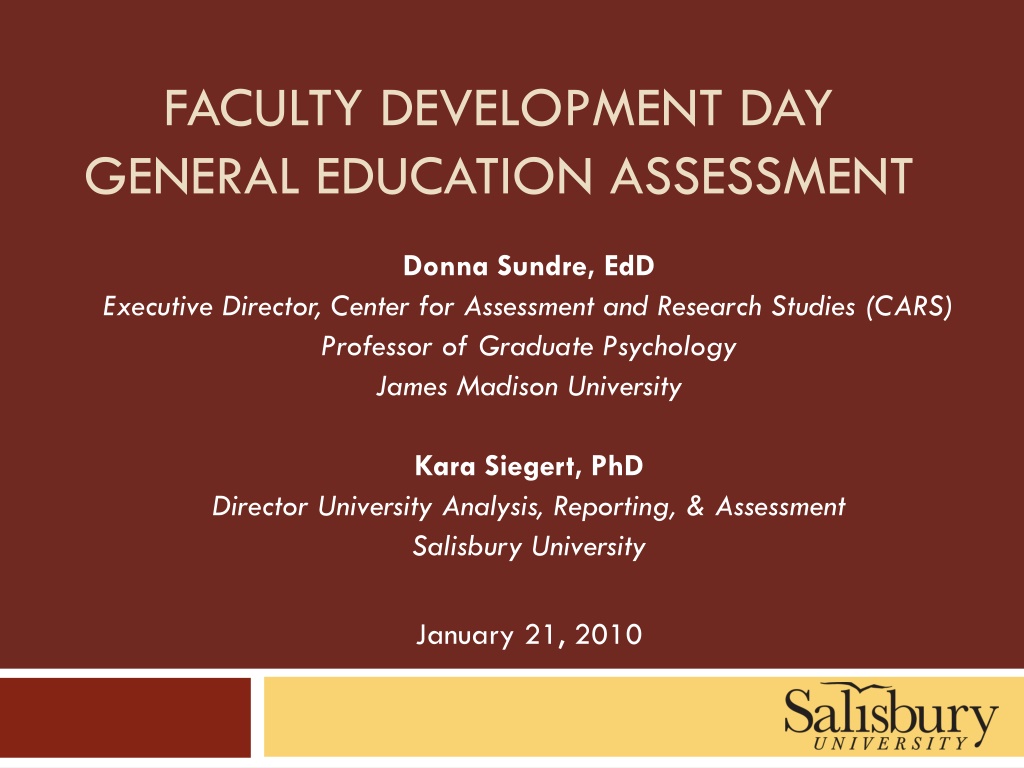
 undefined
undefined









